Weiterer kreativer Ausfluss - diesmal ein Whif mit einem realen, zeitgenössischen Hintergrund. Man mag sich wundern, wie man auf die bekloppte Idee kommt, eine israelische, fast schon antike IAI Kfir als Flugzeug der Bulgarischen Luftwaffe aufzubauen. Doch da ist mehr dran als man denkt, dies könnte sogar Realität werden (siehe Story weiter unten sowie den enthaltenen Link, der ist echt)!
Insofern habe ich die Ereignisse aufgegriffen und ein passendes Modell aus dem Boden gestampft, quasi als Kfir, die nach den aktuellen Anforderungen schon vor ein paar Jahren von Bulgarien gekauft worden wäre. Und dies ist das Ergebnis, die IAI Kfir C.60
 Im herbstlichen Morgengrauen auf Graf Ignatievo Air Base...
Im herbstlichen Morgengrauen auf Graf Ignatievo Air Base... 1:72 IAI Kfir C.60; “542” Bulgarian Air Force, 1/3rd Fighter Squadron, Graf Ignatievo Air Base, 2010 (Italeri kit conversion/Whif)
1:72 IAI Kfir C.60; “542” Bulgarian Air Force, 1/3rd Fighter Squadron, Graf Ignatievo Air Base, 2010 (Italeri kit conversion/Whif) by
dizzyfugu, on Flickr
 1:72 IAI Kfir C.60; “542” Bulgarian Air Force, 1/3rd Fighter Squadron, Graf Ignatievo Air Base, 2010 (Italeri kit conversion/Whif) - Purposely poor beauty pic
1:72 IAI Kfir C.60; “542” Bulgarian Air Force, 1/3rd Fighter Squadron, Graf Ignatievo Air Base, 2010 (Italeri kit conversion/Whif) - Purposely poor beauty pic by
dizzyfugu, on Flickr
"542 White" wartet, dass der MiG-21-Trainer die Startbahn freigibt...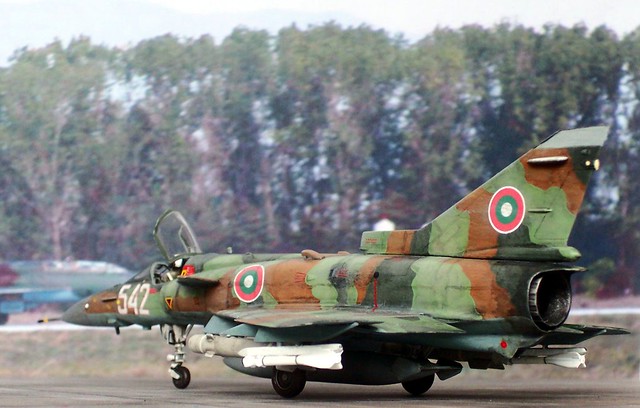 1:72 IAI Kfir C.60; “542” Bulgarian Air Force, 1/3rd Fighter Squadron, Graf Ignatievo Air Base, 2010 (Italeri kit conversion/Whif)
1:72 IAI Kfir C.60; “542” Bulgarian Air Force, 1/3rd Fighter Squadron, Graf Ignatievo Air Base, 2010 (Italeri kit conversion/Whif) by
dizzyfugu, on Flickr
 1:72 IAI Kfir C.60; “542” Bulgarian Air Force, 1/3rd Fighter Squadron, Graf Ignatievo Air Base, 2010 (Italeri kit conversion/Whif)
1:72 IAI Kfir C.60; “542” Bulgarian Air Force, 1/3rd Fighter Squadron, Graf Ignatievo Air Base, 2010 (Italeri kit conversion/Whif) by
dizzyfugu, on Flickr
 1:72 IAI Kfir C.60; “542” Bulgarian Air Force, 1/3rd Fighter Squadron, Graf Ignatievo Air Base, 2010 (Italeri kit conversion/Whif)
1:72 IAI Kfir C.60; “542” Bulgarian Air Force, 1/3rd Fighter Squadron, Graf Ignatievo Air Base, 2010 (Italeri kit conversion/Whif) by
dizzyfugu, on Flickr
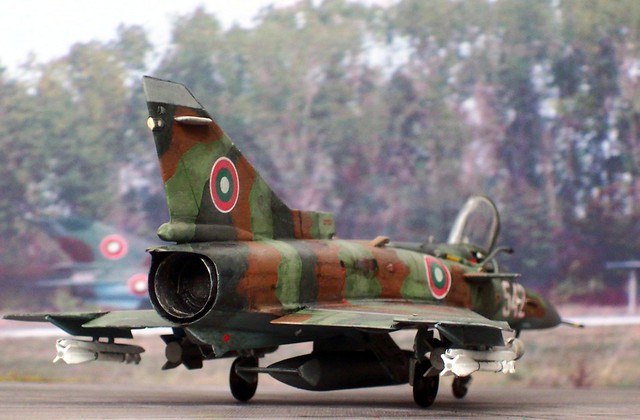 1:72 IAI Kfir C.60; “542” Bulgarian Air Force, 1/3rd Fighter Squadron, Graf Ignatievo Air Base, 2010 (Italeri kit conversion/Whif)
1:72 IAI Kfir C.60; “542” Bulgarian Air Force, 1/3rd Fighter Squadron, Graf Ignatievo Air Base, 2010 (Italeri kit conversion/Whif) by
dizzyfugu, on Flickr
Gesamtansicht & Details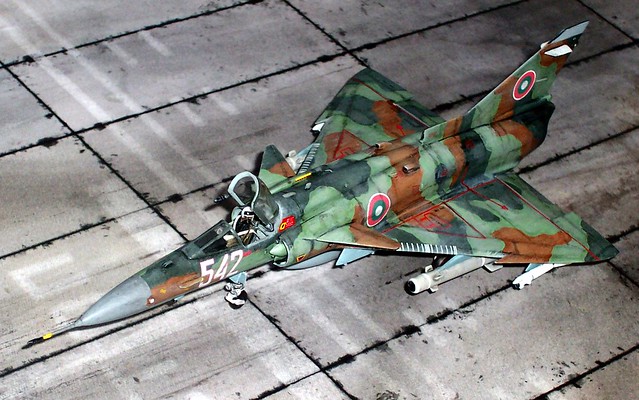 1:72 IAI Kfir C.60; “542” Bulgarian Air Force, 1/3rd Fighter Squadron, Graf Ignatievo Air Base, 2010 (Italeri kit conversion/Whif)
1:72 IAI Kfir C.60; “542” Bulgarian Air Force, 1/3rd Fighter Squadron, Graf Ignatievo Air Base, 2010 (Italeri kit conversion/Whif) by
dizzyfugu, on Flickr
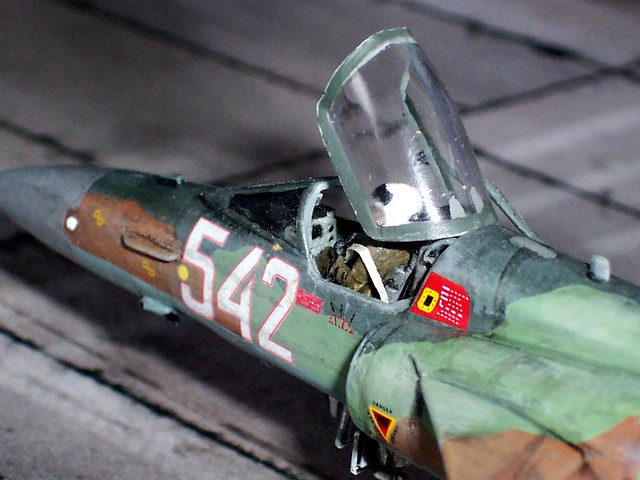 1:72 IAI Kfir C.60; “542” Bulgarian Air Force, 1/3rd Fighter Squadron, Graf Ignatievo Air Base, 2010 (Italeri kit conversion/Whif) - Cockpit detail
1:72 IAI Kfir C.60; “542” Bulgarian Air Force, 1/3rd Fighter Squadron, Graf Ignatievo Air Base, 2010 (Italeri kit conversion/Whif) - Cockpit detail by
dizzyfugu, on Flickr
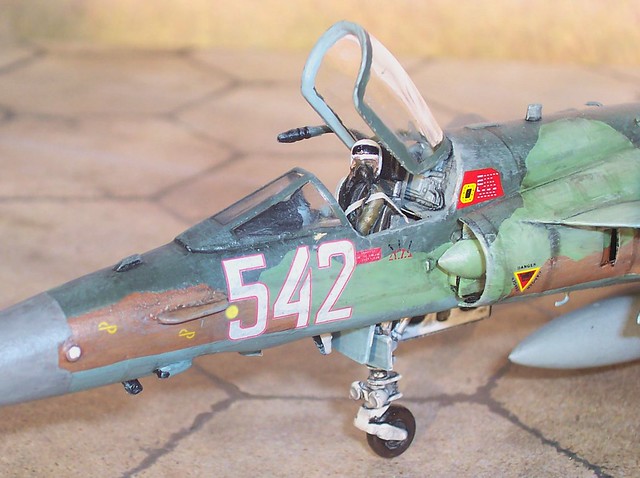 1:72 IAI Kfir C.60; “542” Bulgarian Air Force, 1/3rd Fighter Squadron, Graf Ignatievo Air Base, 2010 (Italeri kit conversion/Whif) - Cockpit detail
1:72 IAI Kfir C.60; “542” Bulgarian Air Force, 1/3rd Fighter Squadron, Graf Ignatievo Air Base, 2010 (Italeri kit conversion/Whif) - Cockpit detail by
dizzyfugu, on Flickr
Zum Modell:Dies war eine Kfir C.7 von Italeri, die aber deftig umgebaut werden musste, um dem C.10/12-Standard zu entsprechen, der Bulgarien angeboten wird (s.u.). Da es kein solches Modell gibt (und auch keinen Umbausatz), habe ich selber Hand angelegt. Größte Änderung ist der komplett neue Bug mit dem Elta-Radar (ein abgesägter Zusatztank eines Tornado ADV), ferner wurden anhand von Fotos realer Kfir C.10 zahlreiche neue Antennen und Pitots gesetzt, denn im Detail unterscheiden sich die modernen Kfirs doch erheblich von den "alten" C.2 und C.7- Versionen.
Hinzugekommen sind außerdem der Luftbetankungsstuzuen (von einer A-4 Skyhawk), ein neuer Sitz, ein Matchbox-Pilot mit separat angeklebten Luftschlauch aus Bindfaden für die Sauerstoff-Maske sowie die quasi-russische Bewaffnung (zwei R-60 AAMs sowie zwei KAB-500Kr-Smartbomben) und die dazugehörigen Träger unter Tragflächen und Lufteinläufen.
Beim Anstrich habe ich mich an zeitgenössichen MiG-21 orientiert - ich finde den dreifarbigen, taktischen Anstrich sehr interessant. Das Schema stammt mehr oder weniger von einem realen Vorbild, einer bulgarischen MiG-21R, von der ich eine Dreiseiten-Ansicht gefunden habe, und die Farben sind anhand von Real-Bildern geraten, kommen m. E. aber gut hin:
● Humbrol 120 (Light Green, FS 34227), aufgehellt & später trockenbemalt mit Testors 2071 (RLM 02 Grey) sowie Humbrol 90 (Sky Type S)
● Testors 2091 (RLM 82 Dunkelgrün), schattiert mit Testors 2081 (RLM 71 Dunkelgrün)
● Testors 1701 (Military Brown, FS 30117), aufgehellt und trockenbemalt mit Humbrol 118 (FS 30219 Tan) sowie Humbrol 63 (Sand)
● Testors 2123 (Russian Underside Blue) für die Unterseiten, abgetönt mit Humbrol 128 (FS 36320, Compass Grey)
Als Experiment habe ich die Panel-Lines mit Tamiya X18 (Smoke) nachbearbeitet, was nicht 100%ig geklappt hat, weil die Farbe zu schnell aufgetrocknet ist (Aber als Idee wierd dies weiter verfolgt werden). Es wurde außerdem ein dünner Schleier aus verdünnter schwarzer Tusche aufgetragen, Schmauchspuren um Triebwerk, Luftauslässe und Kanonen, und schließlich alles mit Humbrol 140 rundum leicht trocken bemalt, um Farben und Decals weiter abzustumpfen. War alles recht aufwändig, aber das Ergebnis finde ich durchaus überzeugend - die Kiste sollte benutzt, leicht ausgeblichen und nicht unbedingt gepflegt aussehen, jedoch nicht verrottet.
Aufkleber sind zusammengepuzzelt: die bulgarischen Hoheitszeichen und Nummer stammen von einem Su-25-Satz von Balkan Models, alle Warnhinweise etc. vom Orginal-Bogen von Italeri, ein paar weitere Beschriftungen kommen aus der Restekiste.
Der Hintergrund:The Bulgarian Air Force (BAF, 'Bulgarski Voyenno Vozdushshni Sili') is one of the oldest air forces in Europe and the world. In the past decade Bulgaria has been trying actively to restructure its army as a whole and a lot of attention has been placed on keeping the aging Russian aircraft operational In recent times BAF aircraft have been actively taking part in numerous NATO missions and exercises in Europe. In 2010, the Bulgarian Air Force's inventory numbered around 137 aircraft, including 55-56 combat jets. But only the MiG-29s and about a dozen Su-25s and a few MiG-21bis were flight worthy, the L-39ZA only used for training.
Since 2000 the BAF planned to retire most of its Soviet-era aircraft, keeping only the Mikoyan-Gurevich MiG-29 'Fulcrum' fleet (which was modernized only recently) as well as its Mi-24 gunships and the Su-25s. The MiG-21s in service were scheduled to be replaced with possible American or European aircraft – and in 2006, a proposal from Israel Aircraft Industries (IAI) won a deal: the delivery of IAI’s Kfir C.60.
The Kfir C.60 was an upgraded version of the C.10, a variant developed especially for export and sold to Ecuador and Colombia. The most important feature of this version is the adaptation of the Elta EL/M-2032 radar, an advanced pulse Doppler, multimode Fire Control Radar intended for multi-role fighter aircraft originated from the Lavi project. It is suitable for air-to-air and air-to-surface mode, including high-resolution mapping (SAR), and offers a high mission performance in all weather conditions. Other new features include two 127×177mm MFD's, HOTAS configured cockpit, a Helmet Mounted Display System (HMD) and in-flight refuelling capability.
A total order of 18 Kfir C.60 was placed, deliveries were completed in April 2008. The planes were actually converted from mothballed IAF C.7 fighter bombers, keeping costs and development time low. The Kfir C.60 is supposed to replace BAF’s vintage MiG-21bis completely, parts of the Su-25 fleet and fill the gap of the fighter bomber role the Su-22 (which had already been retired in early 2004) left.
The Bulgarian C.60 would primarily be used in the ground attack/CAS role, but also augment the small MiG-29 fleet in air defence tasks. Consequently, the Kfir C.60 can not only carry a wide range of air-to-ground ordnance, the planes were also equipped with IR-homing AAMs like the R-60 (AA-8 'Aphid') and R-73 (AA-11 'Archer') missiles of Russian origin, still making up most of the BAF's weapon inventory.
All Kfir C.60 were allotted to the 3rd Fighter Squadron at Graf Ignatievo Air base, where they replaced the leftover ten MiG-21bis at 1/3 Fighter Squadron and grounded Su-25 from 22nd Ground Attack Squadron, formerly based at Bezmer Air Base.
It is uncertain if more Kfirs will be acquired, but chances are good. In January 2011 the Bulgarian MoD issued a Request for Information (RFI) regarding the acquisition of 8 multi-role fighters. The main competitors are expected to be the Eurofighter GmbH Eurofighter Typhoon, Dassault Rafale, Saab JAS 39 Gripen, Mikoyan MiG-29 or MiG-35, or the Lockheed Martin F-16 and Boeing F/A-18 Super Hornet. On March 9, 2011 the Swedish Government submitted its response to the RFI containing 8 new Gripen C/D fighters. The Bulgarian MoD has extended the time limit for submittal of responses by two months due to the lack of responses from the other competitors.
In October 2011, IAI stepped in and offered the Kfir as a new combat aircraft for the Bulgarian Air force (see: http://www.timawa.net/forum/index.php?topic=29248.0) It coincided with the two days visit of Israeli Prime Minister Benjamin Netanyahu in Bulgaria, which may bring another competitor for a new fighter for Bulgarian Air force – a modernized version of the Kfir C.60 already in service. Two weeks earlier the Bulgaria defence minister Anu Angelov was ‘tempted’ by such an offer when visited the IAI booth at the Paris Air show. The supposed price in times smaller compared to the ones offered by the companies requested by the RFI, sent in February to Eurofighter, SAAB, Boeing and Martin Lockheed.
Bulgaria and Israel held a joint session of their governments and signed a defence cooperation agreement on July 7 2011 in Sofia. "This is the first joint session that Israel holds with another country in the (Balkan) region," ministry spokeswoman Vesela Cherneva said. Cherneva added that the two countries will sign a bilateral agreement for defence cooperation, with Israeli companies encouraged to participate in the modernisation of Bulgaria's defence equipment.
However, as stated by the Ministry of Defense the contract for new multirole fighter should be signed by midterm of 2012 and the first machines should start arriving in 2015. Tactical UAV should be procured in support of the land forces operations, too. No decision has been settled upon yet.General characteristics:Crew: One
Length: 16.27 m (53 ft 4½ in)
Wingspan: 8.22 m (26 ft 11½ in)
Height: 4.55 m (14 ft 11¼ in)
Wing area: 34.8 m² (374.6 sq ft)
Empty weight: 7,285 kg (16,060 lb)
Loaded weight: 11,603 kg (25,580 lb) two 500 L drop tanks, two AAMs
Max. take off weight: 16,200 kg (35,715 lb)
Powerplant: 1 × IAl Bedek-built General Electric J-79-J1E turbojet, rated at 52.9 kN (11,890 lbs) dry thrust and 79.62 kN (17,900 lbs) with full afterburner
Maximum speed: 2,440 km/h (1,317 knots, 1,516 mph) above 11,000 m (36,000 ft)
Combat radius: 768 km (415 nmi, 477 mi) (ground attack, hi-lo-hi profile, seven 500 lb bombs, two AAMs, two 1,300 L drop tanks)
Service ceiling: 17,680 m (58,000 ft)
Rate of climb: 233 m/s (45,950 ft/min)
Armament: 2× Rafael-built 30 mm (1.18 in) DEFA 553 cannons, 140 rounds/gun; 5,775 kg (12,730 lb) of payload on seven external hardpoints, including guided and unguided missiles and bombs, air-to-air missiles, reconnaissance pods or drop tanks.
Wie gesagt, das könnte alles sogar noch Realität werden...
